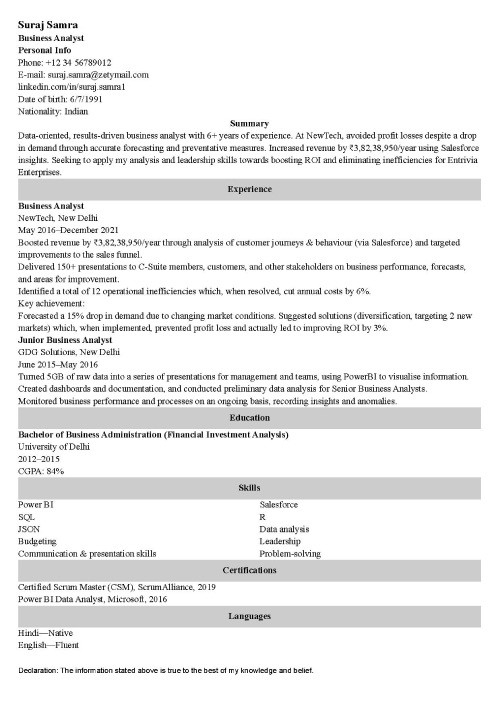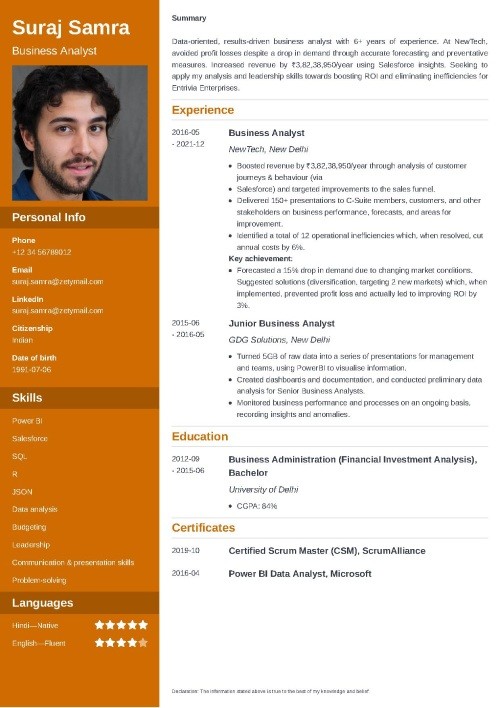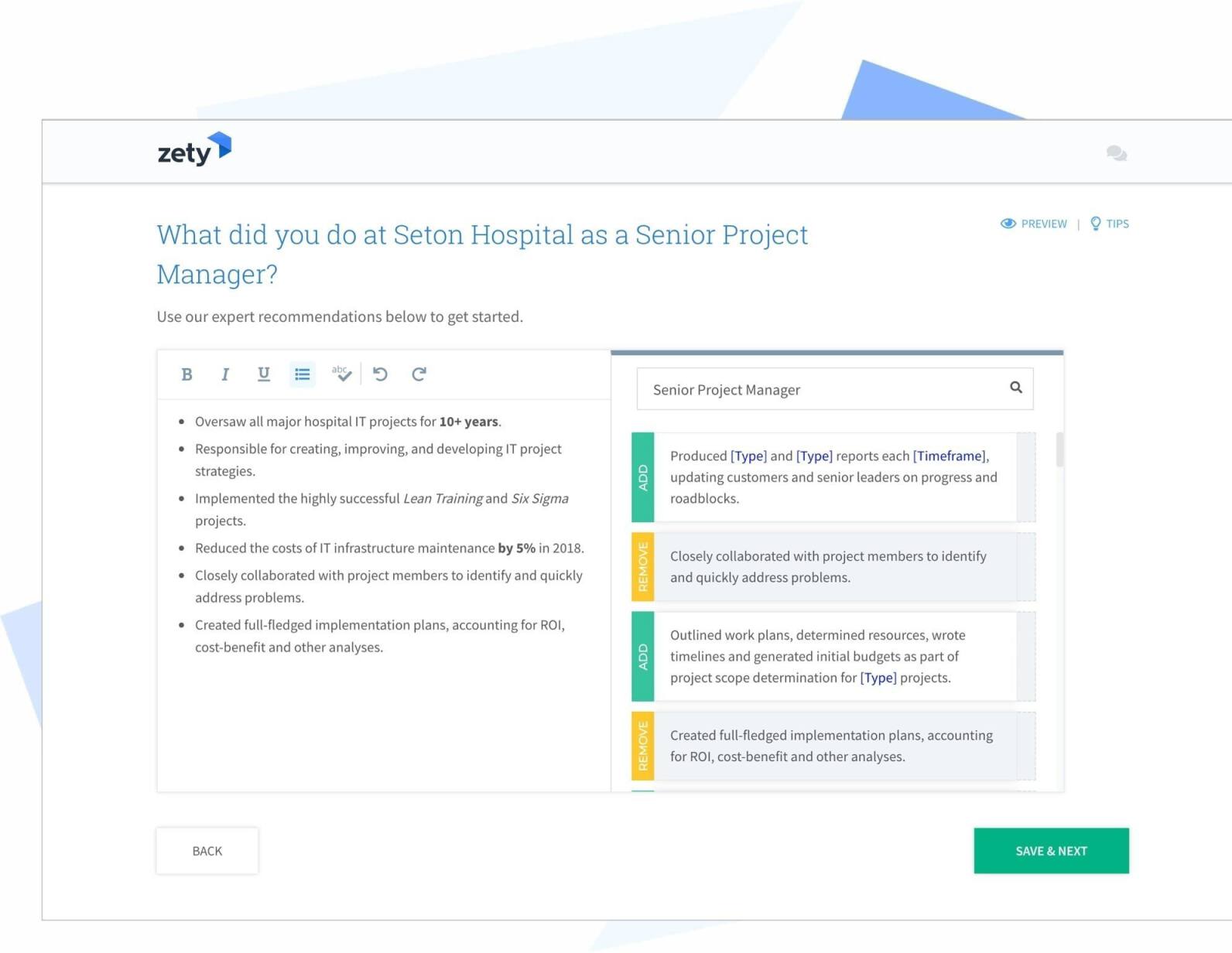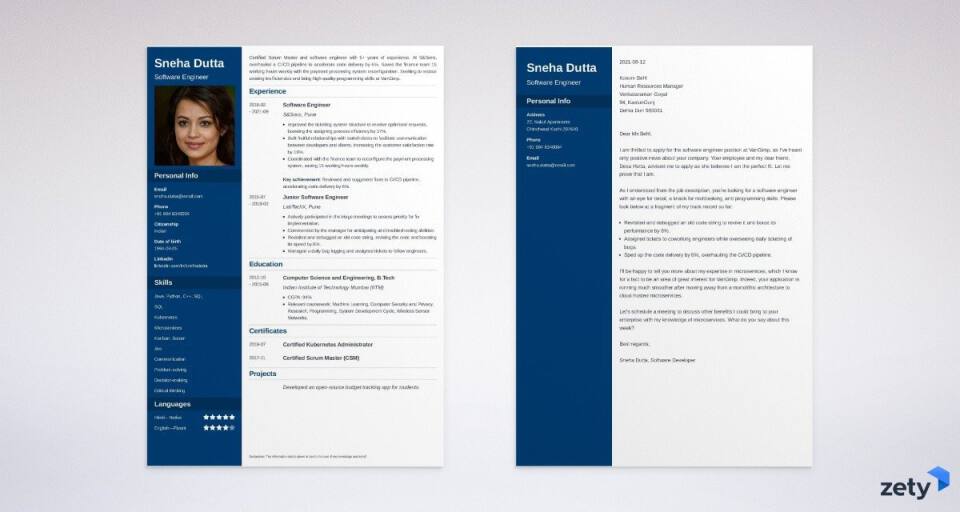How to Make a CV for a Job: CV Writing Guide & Examples
Create your CV nowEveryone knows how to write a CV, right? You list details of your jobs, education, and other relevant experience, that’s all there is to it!
…until you actually sit down to make a CV. That’s when questions begin mounting, until you no longer have the faintest idea what you’re supposed to do.
Today, we’ll answer all of those questions—and then some. Time to learn exactly how to write a CV the right way!
This guide will show you:
- How to write a CV better than 9 out of 10 other CVs.
- Proven tips for CV writing sure to land you an interview.
- A job-winning example to show you how to make a CV that puts your achievements in the spotlight.
Want to save time and have your CV ready in 5 minutes? Try our CV builder. It’s fast and easy to use. Plus, you’ll get ready-made content to add with one click. See 20+ CV templates and create your CV here.


Sample CV made with our builder—See more templates and create your CV here.
How to Write a CV: Example
Suraj Samra
Business Analyst
Personal Info
Phone: +12 34 56789012
E-mail: suraj.samra@zetymail.com
linkedin.com/in/suraj.samra1
Date of birth: 6/7/1991
Nationality: Indian
Summary
Data-oriented, results-driven business analyst with 6+ years of experience. At NewTech, avoided profit losses despite a drop in demand through accurate forecasting and preventative measures. Increased revenue by ₹3,82,38,950/year using Salesforce insights. Seeking to apply my analysis and leadership skills towards boosting ROI and eliminating inefficiencies for Entrivia Enterprises.
Experience
Business Analyst
NewTech, New Delhi
May 2016–December 2021
- Boosted revenue by ₹3,82,38,950/year through analysis of customer journeys & behaviour (via Salesforce) and targeted improvements to the sales funnel.
- Delivered 150+ presentations to C-Suite members, customers, and other stakeholders on business performance, forecasts, and areas for improvement.
- Identified a total of 12 operational inefficiencies which, when resolved, cut annual costs by 6%.
Key achievement:
- Forecasted a 15% drop in demand due to changing market conditions. Suggested solutions (diversification, targeting 2 new markets) which, when implemented, prevented profit loss and actually led to improving ROI by 3%.
Junior Business Analyst
GDG Solutions, New Delhi
June 2015–May 2016
- Turned 5GB of raw data into a series of presentations for management and teams, using PowerBI to visualise information.
- Created dashboards and documentation, and conducted preliminary data analysis for Senior Business Analysts.
- Monitored business performance and processes on an ongoing basis, recording insights and anomalies.
Education
Bachelor of Business Administration (Financial Investment Analysis)
University of Delhi
2012–2015
- CGPA: 84%
Skills
- Power BI
- Salesforce
- SQL
- R
- JSON
- Data analysis
- Budgeting
- Leadership
- Communication & presentation skills
- Problem-solving
Certifications
- Certified Scrum Master (CSM), ScrumAlliance, 2019
- Power BI Data Analyst, Microsoft, 2016
Languages
- Hindi—Native
- English—Fluent
Declaration: The information stated above is true to the best of my knowledge and belief.
Impressive, right?
Now, here’s how to make a CV of your own that’s just as good:
1. Choose the Right Format for Your CV
Picture yourself landing an interview for that job you want. Would you dress up in your best outfit, hoping it will convey your professionalism? Or would you arrive in a t-shirt, assuming recruiters will gather you’re the perfect candidate from your answers?
Exactly.
It’s the same with your CV: even a perfectly written document won’t get a chance if it doesn’t look the part.
So, before we get to writing, here’s how to format your CV to make the perfect first impression:
- Set your margins to one inch on every side and your line spacing to 1–1.15. This will help to make sure you don’t crowd the page with too much text.
- Pick a font that’s easy to read, like Arial or Calibri, and set it to 11–12 points. You may be tempted to get creative with your font choice, but remember: in official documents, the best font is one that you don’t notice.
- Create a CV header with your contact details, including your full name, job title, phone, email, and (optionally) physical address. If you want, you can include your personal data (date of birth, marital status, etc.). Links to social media or your online portfolio, if appropriate, can go here as well.
- Use a professional photo that presents you as a successful, driven, confident candidate.
- Include larger section headings (13–14 point will probably work) to make your CV easy to scan.
- Remember to add your experience in reverse-chronological order (i.e. most recent first)—this is the most popular CV layout that won’t confuse recruiters or recruitment software.
- Try to fit everything on one page only, unless you have many years of experience and lots of relevant achievements—in which case you can go over onto a second page.
- Include a footer with your declaration—it’s a mandatory addition for jobs in India. Something like “Declaration: The information stated above is true to the best of my knowledge and belief.” will work just fine.
Plan enough space for the following CV sections:
- CV profile: a short paragraph to introduce you and your skills
- Work experience: your jobs and career accomplishments
- Education: your highest level of schooling, with optional academic achievements
- Skills: 5–10 skills relevant to the job advertisement
- Other sections: anything else that can help your application, like certifications, foreign languages, projects, and so on.
When you’re done editing your CV, save it as an editable document (like a Word file), but also create a PDF copy to submit to recruiters. The PDF format is reliable and universal: your CV will look the same on every device.
With the document ready, we can now move on to writing your CV!
Read more: What is a CV in India? Curriculum Vitae Definition & Example
2. Start with Your Work Experience Section
Even though your CV profile appears first on the page, let’s start by writing your work history section instead. The profile is a compilation of the best bits of your CV, so it makes sense to write it last.
Now then—
Your work experience is arguably the most important part of your CV, so make sure to spend plenty of time perfecting it. Chances are, if the recruiter reads just one part of your CV, it’ll be this one.
Here’s how to get it right:
- List your jobs in reverse-chronological order, so starting with the most recent or current one. For each entry, add your job title, the name and location of the company, and the time frame when you worked there. Month and year will be enough, no need to look for the exact dates.
- Describe each of your jobs in 4–6 bullet points. Include more information for your most recent or current job and fewer details for older jobs.
- Start each bullet point with a power word—meaning an impactful, strong, active verb. For example, Achieved or Boosted are far more effective than Assisted or Responsible for.
- Focus on your accomplishments, not just on duties and responsibilities. What you achieved in each role is far more important than what the scope of the role was.
- Highlight a separate key achievement if applicable.
- Include numbers like amounts and percentages to quantify your successes and provide context for your achievements.
- If you have a very long work history, don’t go back further than 10–15 years, unless your earlier jobs and achievements are definitely relevant to the job you’re applying for today. If you do include a job from many years ago, keep the entry as brief as possible.
That’s enough theory—
Let’s practice on some CV writing examples:
How to Make a CV: Work Experience Examples
| RIGHT |
|---|
Business Analyst NewTech, New Delhi May 2016–December 2021
Key achievement:
|
Isn’t that far more convincing than a long, overly detailed description of every little thing this person was responsible for? This is what your CV will look like if you stick to achievements over duties!
Meanwhile, this is how not to do it:
| WRONG |
|---|
Business Analyst 2016–2021
|
This is not terrible… But we already know it could be made miles better with just a bit more effort. The wrong example tells us what the candidate did, but it doesn’t prove that they actually did it well, does it? The numbers, the context, and the active verbs make all the difference.
But what if you don’t have that much experience?
Don’t worry: the same techniques can be applied to fresher CVs with equal success. Observe:
How to Write Experience in a CV: Fresher Examples
| RIGHT |
|---|
Junior Business Analyst GDG Solutions, New Delhi June 2015–May 2016
|
This candidate didn’t do or achieve anything extraordinary—all of these bullet points are pretty typical for this role. But the way they’ve described their experience using active verbs suggests they were proactive and efficient.
Unlike this candidate:
| WRONG |
|---|
Junior Business Analyst GDG Solutions, New Delhi June 2015–May 2016
|
Yaaaawn.
Boring and unimpressive, right?
Note that the experience and tasks are exactly the same in both examples—it’s just that the first one does a much better job picking the right words to describe it.
And now you know how to do the same on your CV, too!
Making a CV with our builder is incredibly simple. Follow our step-by-step guide, use ready-made content tailored to your job and have a CV ready in minutes.
When you’re done, Zety’s CV maker will score your resume and tell you exactly how to make it better.
3. Make Your Education Section Count
Would you believe that the hardest part is already behind you?
It’s true!
If you’ve finished polishing your work experience section, all that’s left to do now is to fill in the blanks—
Starting with your education section.
Even if you have lots of experience or your job doesn’t require formal education, it would still look unprofessional to completely skip this part. So, here’s how to go about it:
If you have a few years of relevant experience, include only:
- Your highest level of education and your field of study, e.g. MSc in Computer Science
- The name and location of the awarding institution, e.g. University of Delhi
- Years of attendance or graduation year
- Your CGPA
Here’s an example of how to format your entry:
CV Writing Examples: Education [Experienced]
| RIGHT |
|---|
Bachelor of Business Administration University of Delhi 2012–2015
|
Pretty simple, right?
Things get a bit more complex, however, if you have little to no professional experience. In such cases, it’s worth boosting your education section with extra information—
This can help to show off your skills and talents, as well as bulk out your CV a bit. You don’t want to send in a half-empty page, after all!
So, consider adding things such as:
- Relevant coursework you completed. This is particularly helpful for including resume keywords, such as specific skills or software proficiencies.
- Your extracurricular activities. Were you involved in any clubs, sports teams, or other academic organizations? If so, it’s usually worth mentioning them here—they can show your skills and motivation, after all.
- Academic achievements. If you accomplished something out of the ordinary, definitely add it to your CV: it’ll show you’re a fast, talented learner.
Lastly, if you’re still in the process of obtaining your degree or you have nothing to put on your CV apart from your education, add your earlier schooling (10th & 12th class).
Let’s take a look at a fresher education section example:
Sample How to Write a CV: Education [Fresher]
| RIGHT |
|---|
BSc in Computer Science University of Mumbai Expected graduation: 2022
12th Class (HSC) Dombivli Public College, Dombivli
10th Class (SSC) Dombivli High School, Dombivli
|
Pro tip: What about internships? If you have no experience at all other than the internship, list it as your work experience. If you have had other jobs, mention your internship(s) in your education section.
4. List the Right Skills on Your CV
The more skills you put on your CV, the better, right?
Wrong.
Overstuffing your application with buzzwords won’t get you far. Instead, a targeted approach is a much smarter alternative.
5 to 10 skills on your CV will be enough, and here’s how to pick them:
First, make a list of all your professional skills. Remember to include:
- Hard skills—specific knowledge typical for your field, like curriculum planning for teachers or high typing speed for administrative roles.
- Soft skills—qualities useful in all professions, like communication, teamwork, or critical thinking.
- Computer skills or technical skills—you can think of those as the general ability to use a computer, but it’s usually best to list specific computer skills on your CV—like software proficiencies, systems analytics, or backup and recovery, for example.
Done? Alright—
Now, take another look at the job advertisement to which you want to apply. Read it again carefully, looking for keywords and specific skills.
Lastly—you guessed it—compare your list with the skills from the ad. There are bound to be some matches! Pick 5–10 of the most relevant ones, and put those on your CV.
This may feel like a lot of messing around, sure—but it’ll get easier with time. Now that you’re aware of all your skills, tailoring your CV to each job ad will be much quicker!
This isn’t just done for the recruiter’s benefit, either: companies use software that scans job applications, looking for keywords pertinent to the ad. So, the more of those keywords you include (within reason, of course), the better your chances of getting the green light from Applicant Tracking Systems.
Are there any universal skills that will work for every CV, though? Yes, to an extent—
According to research from Rasmussen University, the top skills employers look for include communication, time management, critical thinking and problem-solving, teamwork, emotional intelligence, digital literacy, and initiative. It goes without saying that these would look great on your CV, mixed with some hard skills specific to your profession.
Like so:
How to Create a CV: Skills Example
| RIGHT |
|---|
Skills
|
Pro tip: Got some skills that didn’t make the list, but should still be included? No problem: you should be weaving your key skills into the other sections of your CV, anyway! Mention them in your profile and job descriptions.
5. Add Other Sections to Your CV
Okay, there’s your experience and your education… but there’s so much more that didn’t make the cut! What about your certificates, projects, volunteer work?!
Don’t worry.
That’s where bonus sections come in.
Consider adding the following to your CV:
- Certifications and licences: list the name of the certificate or licence, the awarding body, and the year you obtained it. If you want to include more than one entry, arrange them in reverse-chronological order (most recent first).
- Foreign languages: worth mentioning for literally every job. List the foreign languages you speak (alongside your native one, if you wish to include it), complete with your proficiency level. Arrange entries by fluency, i.e. start with the language you know best and move on to ones you’re less familiar with.
- Awards or special achievements: list only those that you haven’t already mentioned in your work experience or education sections.
- Memberships in professional associations: if possible, list activities you took part in during the course of your membership (e.g. attending conferences, holding workshops, mentoring).
- Volunteer work: if you have volunteering experience, mention the place where you volunteer(ed) and your tasks there. If it’s relevant to the job you’re after, you can format your volunteering experience with more detailed bullet points.
- Publications and projects: published a book, an article, or a research paper? Completed an impressive personal project? Show it off!
- Hobbies and interests: if you have a passion that requires the same skills as the job you’re applying for, then by all means add it to your CV.
Here’s what these bonus sections can look like on a finished CV:
How to Make a CV for a Job: Extra Sections [Example]
| RIGHT |
|---|
Certifications
Languages
Interests
|
| WRONG |
|---|
Other ScrumMaster and Power BI certifications Fluent in English My interests include making YouTube videos, reading, and hiking. |
None of these sections are strictly mandatory, but as you can see, when done correctly they can really boost the value of your CV. There’s one key rule, though:
Everything you include must be relevant to the job in some way. Otherwise, it’ll just take up space that you could use for something more impactful.
6. Write a Strong CV Profile—Objective or Summary
Remember how we left writing your CV profile for last? Well, last has come—
Let’s start with some definitions, just to make sure we’re on the same page:
A CV profile is a short paragraph located at the top of the page, just below your CV header. Its purpose is to grab the reader’s attention and immediately show that you’d bring value to the company if hired. Basically, it highlights the best bits of your career or proves your potential. Now—
There are two types of CV profiles: a summary and an objective.
A CV summary is best for candidates with 2+ years of experience. Here’s how to write yours:
- Start with an adjective, such as proven, creative, personable, or data-driven—pick a quality that works best for your profession.
- Add your job title, years of experience, and a couple of your key skills. E.g. Proven civil engineer with 5+ years of experience and excellent AutoCAD and leadership skills.
- Outline your most impressive, relevant professional accomplishment (or two). Include plenty of numbers and power verbs for extra impact. Since you’ve already described your achievements in the rest of your CV, just read through your document again and see what stands out the most.
- End on an offer to apply your skills and expertise towards achieving a specific goal for the company. Make sure to use the name of the company you’re applying to.
Neat formula, right? Let’s see it in action:
How to Write a CV for a Job: Summary Examples
| RIGHT |
|---|
Data-oriented business analyst with 6+ years of experience and outstanding communication and teamwork skills. At NewTech, avoided profit losses despite a drop in demand through accurate forecasting and preventative measures. Increased revenue by ₹3,82,38,950/year using Salesforce insights. Seeking to apply my analysis and leadership skills towards boosting ROI and eliminating inefficiencies for Entrivia Enterprises. |
Notice how those numbers stand out! This candidate managed to squeeze in two big achievements and four key skills into just four sentences, without compromising on readability. The targeted offer at the end leaves the reader with the immediate impression that this person knows the company well and is ready to bring immediate value.
Unlike in this example:
| WRONG |
|---|
I’m a business analyst with extensive experience in a wide range of corporate business environments. Thanks to my experience and education, I’m able to make accurate predictions and draft forecasts that help businesses grow. Have experience in Salesforce. I’m always looking for ways to develop professionally and when I find something I’m passionate about, I apply myself wholeheartedly to achieving goals. |
You’re thinking it too—
Who cares?
With almost the same word count as the right example, the wrong summary fails to convey a single concrete reason why this person should get the job. Anyone can say they’re good at forecasting—the key is to prove it with a measurable achievement from previous experience.
Speaking of previous experience—
What about fresher candidates, who don’t have career accomplishments to share yet?
This is where the CV objective comes in. Let’s see what it looks like, done well… and not so well:
How to Write a CV: Examples for Objective
| RIGHT |
|---|
Driven, personable Computer Science graduate (94% CGPA) determined to apply proven data analysis, R, Python, and teamwork skills towards improving forecasting and performance monitoring for Entrivia Enterprises. Achieved 2nd place in the 2019 Python Coding Championship at the University of Mumbai. |
See?
Even with no experience outside school, it’s possible to write an eye-catching objective. The key is to show your passion and weave in proof that you have the right skills for the job.
Unlike this candidate:
| WRONG |
|---|
Recent University of Mumbai graduate (Computer Science) seeking my first job in data analysis or similar. Good Python and R skills. I’m communicative and personable, enjoy working in a team, and can learn new things quickly. |
That’s nice—
What’s in it for the company, though? And what’s there to prove that this person really can use Python and R?
As you can see, the formula for a great CV objective is the same as for a summary, except that you’ll need to substitute professional achievements for academic ones and focus on showing your enthusiasm and motivation.
An objective is also the profile of choice for career-change CVs, by the way. If you’re writing one of those, just rely on your transferable skills and experience (i.e. things you’ve done and learnt in your previous career that can also be helpful in your new job).
7. Attach a Cover Letter to Your New CV
And that’s it!
…for your CV. There’s still a cover letter to write.
Yes—no one likes writing cover letters, we know. But they really are necessary. Think about it:
Will a recruiter believe that you truly care about getting the job if you couldn’t even be bothered to spend an hour writing a short cover letter?
A cover letter is your chance to convince the hiring manager to give you a call, so it really makes no sense to waste the opportunity.
Convinced? Good—
Here’s a quick breakdown of how to write a cover letter for your CV:
- Use the right cover letter format and a template that matches your CV.
- Address your cover letter directly to the recruiter (or the person who’ll read it).
- Start with an achievement. It’s the same principle as in your CV summary: you’re grabbing attention and proving you’re a strong candidate from the get-go.
- Describe more of your skills and accomplishments in the body of the letter. Show that you understand what the role involves and explain why you’d be a good fit.
- End on a call to action and an offer to achieve a specific goal for the company.
Done right, a cover letter should be no more than four paragraphs and fit on one page. So it’s not that hard, after all!
Still at school? Don’t have experience? Read more: How to Write a Cover Letter for an Internship in India
A great cover letter that matches your CV will give you an advantage over other candidates. You can write it in our cover letter builder here. Here's what it may look like:
See more cover letter templates and start writing.
Key Takeaway
Here’s a recap of how to make a CV:
- Format your document the right way or use a ready-made, professional-looking CV template.
- Include an impactful summary or objective to catch the reader’s attention.
- Keep them invested with a list of your accomplishments in the work experience section.
- Prove you have the right theoretical background by listing your education.
- Add a list of carefully chosen skills, tailored to the job ad, and personalise your CV with extra sections.
- Write a cover letter to prove you’re determined to get the job.
About Zety’s Editorial Process
Our editorial team has reviewed this article in depth to make sure it follows Zety’s editorial guidelines. We’re committed to sharing our expertise and providing actionable career advice that brings real value. Each year, the high quality of our content draws 40 million readers to our site. But that’s not all—we conduct original research to obtain an exhaustive understanding of the labour market and pride ourselves in being cited by top universities and leading media outlets worldwide.





